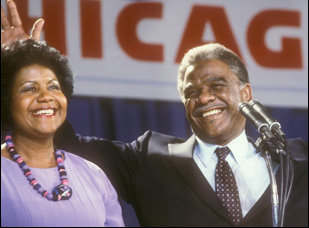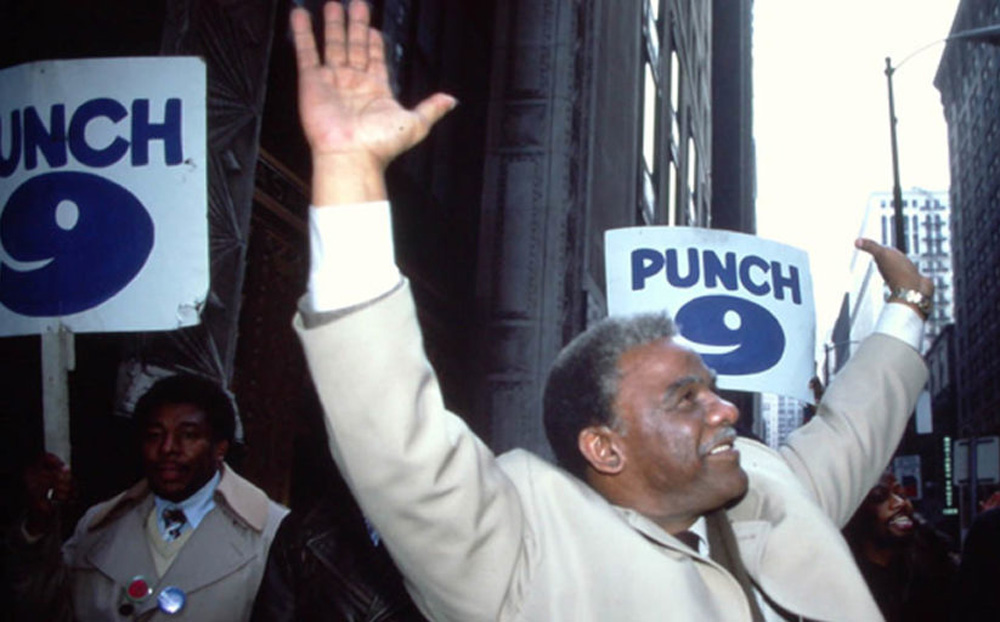In “Punch 9 for Harold Washington,” future Obama political strategist and then Chicago Tribune beat reporter David Axelrod recalls a blizzard that swept the Windy City in 1979, with the local government temporarily shutting down public transit to areas predominantly of color, which it could do with nearly surgical precision after the city had been geographically designed to segregate Black and white communities. It was hardly the only instance in which the greatest number of potential voters in the city had literally been left out in the cold, having seen Winston Frost, the president pro tem of the city council who was by tradition due likely to succeed the late Richard Daley as the first Black mayor of the city following Daley’s death in 1976, only to be denied by the white aldermen who held the power in the city council, and let down by one politician after another who had come to the community to collect votes before almost immediately reneging on the promises they had made.
That “Punch 9” moves like a freight train — or better yet, one of those Chicago L-trains when it’s working right — is maybe the greatest testament director Joe Winston could offer to its subject Harold Washington, who shocked the establishment to become the first African-American to lead the city. Although the pace is relentless, the film is a much-needed reflection on how much it takes to break through entrenched power and that it often takes someone of Washington’s rare combination of charisma and political savvy to make an impression on voters when advocating for radical changes to the system, but there’s an entire movement that they carry along with them. While Washington’s untimely death mere weeks into his second term in office, just after settling all the bitterly fought battles over his authority in the first, leaves the question of what could’ve been, the steady stream of familiar faces shown to either actively contribute to the Washington campaign or inspired by it who would play integral roles later in national politics — President Obama recalls his move to Chicago was a direct reaction to seeing what Washington achieved there — become a moving tribute to his ongoing impact.
With Winston and editors Alex MacKenzie and Melissa Sterne summoning the excitement of Washington’s candidacy in archival footage that appears even crisper than the time in which it was captured in the early ‘80s, “Punch 9” does little to suggest it’s recounting history rather than bring its lessons into the present tense as areas even greater than Chicago confront the same issues that Washington was up against in making sure the political will of his constituents was honored and as it makes its premiere at DOC NYC this week following a hometown bow, the director spoke about how he strived to make a film that would meet this moment while giving such a galvanizing figure such as Washington his due.

That is exactly what propelled me to this project. I’m a native Chicagoan and Harold Washington was basically a neighbor of mine. I was in high school just a few blocks from where Harold lived, when he was elected mayor. Harold Washington is an amazing character, just to see the tape of him. And I got to watch dozens and dozens and dozens of hours of him, and I never got tired of hearing him speak. But what really drew me to his story was the almost political thriller nature of his ascension to power in Chicago. It feels like a “Twilight Zone” episode for all the political struggles that we face today, That he competes in a democratic primary against two white candidates – he squeaks out a victory [where] he’s the dark horse, the improbable underfunded candidate, and everybody’s like, “Who’s this guy?” Suddenly, all the white Democrats switch parties and become Republicans. And the Republican runs this campaign against him where his slogan is “Before it’s too late.” Harold squeaks out another victory, and suddenly the formerly docile Chicago City Council full of cronies and crooks and old alderman decides to rebel and form a shadow government and obstruct everything the mayor does for three years. When Obama was elected president, all of that really hit home for me, that that was such a surprise to so many people, but it was not a surprise to me because I had seen it before in Chicago.
And in Chicago, Harold is a titanic figure. There’s probably eight or nine municipal buildings, parks and monuments named after him and at the same time, he’s not that well known outside of Chicago any more. He made a big impact, but of course he died too young, and I was amazed that 30 years after his death, nobody had made a movie about him that had reached a wide audience and this was the last opportunity to do it while a number of his contemporaries, supporters, friends and enemies are all still living.
And you’ve got a number of people who became part of the Obama Administration like David Axelrod and Valerie Jarrett somehow connected to the Washington administration, and a lot of famous faces now such as Chance the Rapper and Oprah who are shown to have connections to this time in Chicago. What was it like knowing there could be that recognition for contemporary audiences in telling this bit of history?
Yeah, for people who follow politics, there are these major figures who appear in our movie who readily traced their roots to their work for Harold Washington and that’s part of Harold’s legacy. He left us too soon and he didn’t have a successor and he doesn’t even have much family that survives him, so his legacy really is talented people, many of whom were young at the time who, came of age with his politics of multiracial, multiethnic coalition building around liberal values.
And it was very important to me and the team to make this a story that’s relevant, that’s current and is a roadmap for what people can do now. Of course, I mean, it was just an exciting time in Chicago. You speak of Oprah [who’s in the film as a news anchor] and her humble beginnings, and she came to Chicago from Baltimore and then became who we know her as now, so it’s fun to present those people that are still famous, and it helps us connect, but of course the issues are what are really going to resonate with most viewers. [So the question was] how can we recreate this kind of progressive moment of people coming together when the liberal coalition always seems so fragile?
One of my favorite sequences in the film is that coalition building sequence in the middle where you can feel the energy of moving from neighborhood to neighborhood, appealing to various constituencies. What that was like to put together?
Well, [Harold’s] campaign appearances are electric. And there’s certain moments like when he appears with Muhammad Ali, who also lived in the same neighborhood as him at that time, and Harold’s connection with voters and certainly seeing the sort of outreach that he did to various communities [such as] with Hispanic and Latino voters that was fascinating. And we were able to find some documentary footage that nobody has seen [from a] film that only aired once on local TV. The director happened to be family friend and he still had all the tapes in his basement — 70 hours of documentary footage, and from that, we were able to draw on some of the groundwork that Harold and his campaign were doing in the neighborhoods as part of that great, gritty 1980s texture that we get.

I feel like we made the film I had in my head, because [although] I was young, I was here when the story was taking place and I read every book that I could find about it. I remember we spent like an entire week, like me, two editors, an assistant, another producer hunting for one of the famous words that Harold would use that would baffle reporters — antediluvian. He would call things “antediluvian” that he thought were outdated. And we were just hunting through all this and we finally found it, it was like a nugget of gold because this was the Harold we all remembered. It was kind of reconstructive surgery more than anything else. I was trying to present Harold as good as I remembered him.
And creating these kind of documentaries from archival footage is just a ton of shovel and spade work because you have the local news stations, they don’t save much, and you have these news packages to work from, but you’re using every frame of all the good scenes. And to do a film like this, you’ve got to find something that people haven’t seen, something that’s more like raw footage that you can really edit from. That was a real challenge because of the time that had passed and because that era was recorded in videotape and these videotapes are fragile, they’re disintegrating.
It’s remarkable what you find and when the parallels with the present are so striking, was what was going on politically or with the Black Lives Matter movement while you were making this influencing the cut at all?
What you’re describing the connection between past and present is really the genesis of this film. To me, the Harold Washington story is like a parable and it’s kind of the gift that keeps on giving. It took years to make this film. Barack Obama was president when we begun, and that was the framework — that we had a black president in the white house who owed some of his political beginnings to a trailblazing black mayor in Chicago, but then of course, a lot of things happened while we were editing the film and it never changed the story. It just made different parts of it seem richer at various times.
What was the premiere at the Chicago Film Fest like?
Certainly, the Chicago screening was very emotional. These stories are hard to make because raising the money is really hard and there’s a lot of research and it takes a while to do. So it’s a labor of love and the team — my producers Raymond Lambert and Sonya Jackson — and I were really thrilled to finally share this with people and we’re in a big auditorium, it’s packed. And people were sobbing and very moved. Of course, there were people there who’d been in the movie or knew Harold personally, so there was an added layer of meaning to them. And lot of people probably hadn’t been to a movie theater in a couple years. I know I hadn’t. That’s an endangered species of experience, but I have hopes. I have two children, two boys — 11 and 13 — who basically only want to see Marvel movies. Everything else we have to strap them down for, and my 13-year-old said, “This is the least boring documentary I’ve ever seen.” [laughs]
“Punch 9 for Harold Washington” will screen at DOC NYC on November 18th at 9:30 pm at the Cinepolis Chelsea and available virtually on the DOC NYC online platform from November 14th through 28th.




